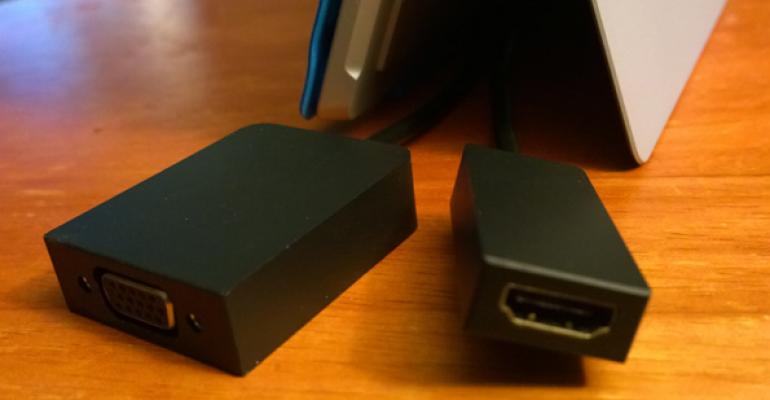Like previous Surface models, Surface Pro 3 comes with a bare minimum of expansion ports, perhaps in a bid to keep the device as clean and elegant looking as possible. But given the size of this device, and the real world needs of typical users, just a few additions would have made a huge difference.
Here are your hardware connectivity options.
USB 3.0
Here, we see the biggest problem with Surface Pro 3 expansion: There's only a single USB 3.0 port. I've been arguing since the original Surface launch that these devices need at least two, and with Surface Pro 3's bigger size, this omission is particularly problematic. Just hours after receiving my review unit, for example, I wanted to use an external mouse (with a USB dongle) while acquiring photos from my phone over USB. But there is only one USB port.

From left to right: Power connector, USB 3.0, miniDisplayPort.
This is particularly problematic if you need Ethernet since Microsoft's Surface Ethernet adapter is, wait for it, USB-based. So if you use this Ethernet adapter, you've sopped up the only USB port.

At the very least, Microsoft should have added a proprietary port for Ethernet. But it should have added a second USB port, too. There's plenty of room for both.
Micro-SD
Like Surface Pro and Pro 2, Surface Pro 3 offers micro-SD expansion, neatly hidden behind the kickstand as before.

I like this arrangement, and while some may be clamoring for SD expansion, I think this makes the most sense. That assumes of course that you're just buying a card and leaving it there: The size of micro-SD and the positioning of this slot combine to make frequent swap-outs less than ideal. (Though the new kickstand certainly makes it easier to access the slot than before.)

Video out
Like Surface Pro 2, Surface Pro provides a standard Mini DisplayPort port, to which you can connect a Mini DisplayPort cable or a VGA or HDMI adapter. I've not used any with the Surface Pro 3, but I do have all three, and I've confirmed that this is the same port. That is, existing cables and adapters work just fine.

VGA adapter

Dock
If you're familiar with the Surface Pro Docking Station that Microsoft introduced with the Surface Pro 2, you know that this peculiar device is really just a port extender: Instead of using a dedicated dock port, it provides pass-through capabilities for the USB 3.0 and video-out ports, and thus must be aligned rather carefully with the Surface Pro/2. That unit provides a single USB 3.0 port, two USB 2.0 ports, mini-DisplayPort video-out (at up to 2560 x 1600), 100 Mbps Ethernet, headphone/speaker (audio out), and microphone (audio in).
For Surface Pro 3, the new Docking Station—which I do not have—is a different animal altogether.

First, the expansion possibilities are better. It will feature two USB 2 ports and three USB 3 ports, a 4K-capable mini-DisplayPort connector, and Gigabit (1000 Mbps) Ethernet. So that's all much improved.
Second, the new Docking Station does not pass-through the USB and video-out; those ports are now too high on the Surface Pro 3. Instead, everything goes through the redesigned new power port on the device. This is far more sophisticated and should lead to better performance too.
This new Docking Station will cost $200, just like the previous unit. But because it's a real dock and not a pass-through/port extender, it may be worth the premium. I'm looking forward to using and reviewing this accessory.





